To capture stunning drone shots of ancient landmarks, start by choosing a drone with a 4K camera and 3-axis gimbal. Master various heights and angles to reveal unique perspectives. Shoot during golden hour for ideal lighting. Always respect local regulations and plan your flight path carefully. Utilize panoramic shots to showcase the entire structure and its surroundings. Highlight the scale of monuments by including people or modern elements. Enhance your footage with post-processing techniques, and tell a compelling story through your shots. Remember to prioritize safety and respect for historical sites. These tips are just the beginning of your aerial photography journey.
Choose the Right Drone
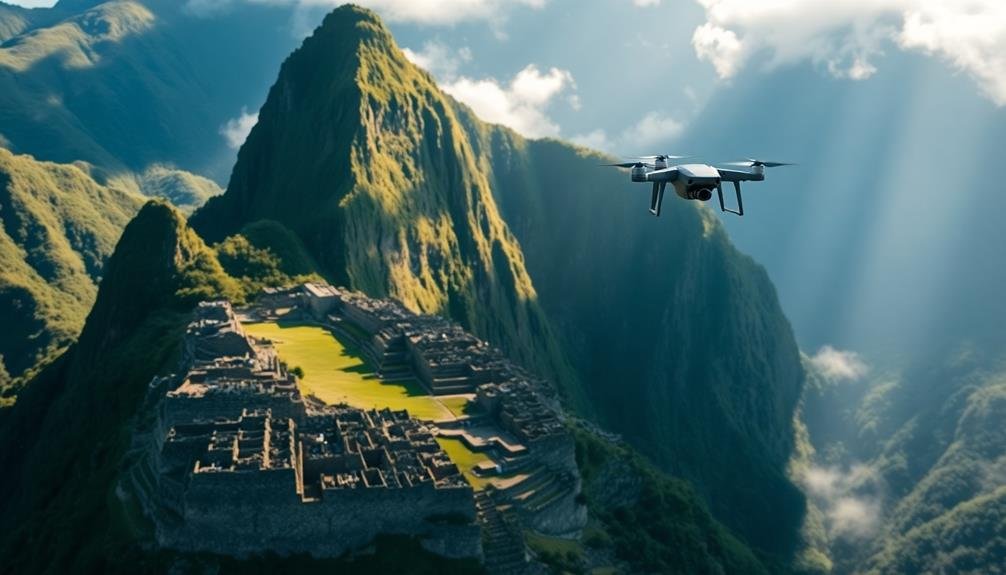
When it comes to capturing breathtaking aerial shots of ancient landmarks, choosing the right drone is vital. You'll want a model that balances image quality, flight time, and portability. Look for drones with at least a 4K camera and a 3-axis gimbal for stable footage. Consider models with adjustable aperture and ISO settings for better control in varying light conditions.
Battery life is essential, so opt for drones that offer at least 25-30 minutes of flight time. This guarantees you have enough time to set up shots and capture multiple angles.
Portability is also key when traveling to ancient sites. Foldable drones are ideal for easy packing and transportation.
Don't forget about intelligent flight modes. Features like orbit, waypoints, and tracking can help you create stunning cinematic shots of landmarks. Look for drones with obstacle avoidance systems to protect your investment when flying near structures.
Lastly, check local regulations regarding drone use at historical sites. Some locations may require permits or have strict no-fly zones. Choose a drone that's compliant with these rules to avoid legal issues and guarantee a smooth shooting experience.
Master Height and Angles
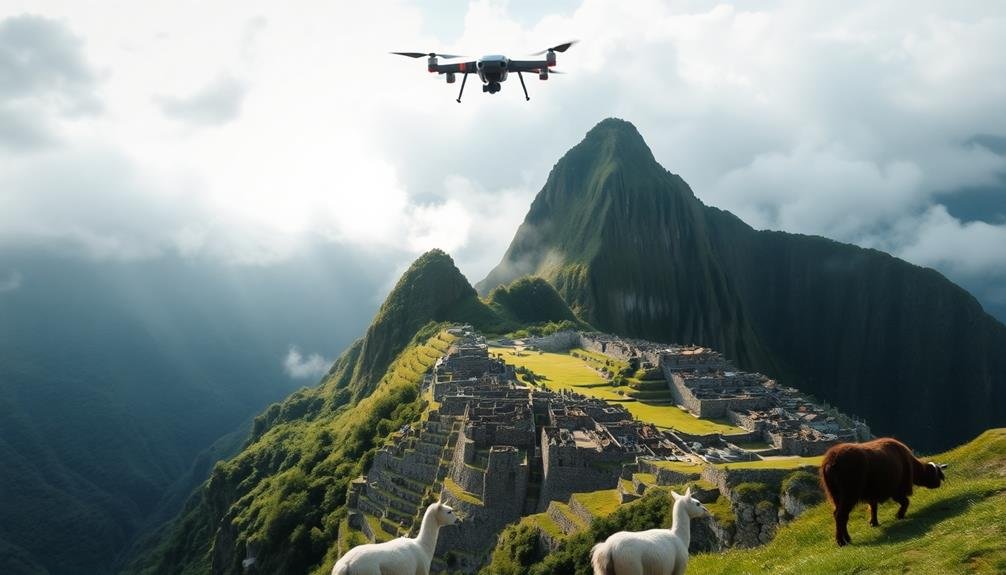
With the right drone in hand, it's time to focus on mastering height and angles for stunning aerial shots of ancient landmarks. Experiment with various altitudes to capture different perspectives of the site. Lower heights can emphasize intricate details and textures, while higher altitudes provide a grand overview of the entire structure and its surroundings.
Pay attention to the sun's position and use it to create dramatic shadows or highlight specific features. Don't limit yourself to straight-on shots. Explore unique angles that showcase the landmark's architectural beauty and historical significance. Diagonal approaches can add depth and dimension to your images, while top-down views offer a rarely seen perspective.
Remember to respect local regulations and maintain a safe distance from the landmark. To elevate your drone photography of ancient landmarks:
- Use the rule of thirds to compose visually appealing shots
- Capture the landmark at different times of day for varied lighting effects
- Incorporate surrounding landscape elements to provide context
- Experiment with slow panning movements for cinematic footage
Capture at Golden Hour
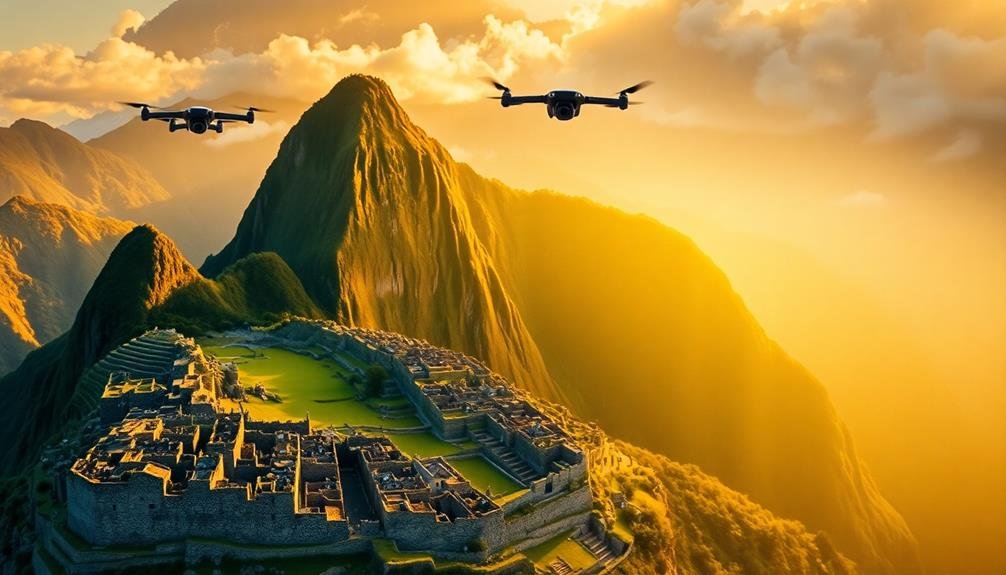
Embrace the magic of golden hour to transform your drone shots of ancient landmarks into breathtaking masterpieces. This fleeting period just after sunrise or before sunset bathes everything in a warm, soft light that's perfect for capturing the intricate details and textures of ancient structures.
To make the most of golden hour, plan your flight well in advance. Check the exact times for sunrise and sunset at your location, and arrive early to set up. Position your drone to capture the long shadows cast by the landmark, which can add depth and drama to your composition.
As you shoot, experiment with different angles to see how the changing light interacts with the monument's features. Don't forget to adjust your camera settings for the unique lighting conditions. Lower your ISO to minimize noise, and use a wider aperture to let in more light.
Consider shooting in RAW format to give yourself more flexibility in post-processing. Remember, the golden hour doesn't last long, so work quickly and efficiently. With practice, you'll capture stunning drone footage that showcases ancient landmarks in their most enchanting light.
Respect Local Regulations

Although capturing stunning drone footage of ancient landmarks is exciting, it's crucial to respect local regulations. Many countries have strict rules governing drone usage, especially around historical sites. Before you take flight, research the specific laws of your destination.
You'll need to know about permit requirements, no-fly zones, and any restrictions on altitude or proximity to structures. Violating these regulations can result in hefty fines, confiscation of your equipment, or even legal trouble. It's not worth risking your drone or your freedom for a shot.
Additionally, respecting local rules shows consideration for the site's preservation and the safety of visitors.
To make sure you're flying responsibly:
- Check with local authorities or tourist information centers for up-to-date drone regulations
- Look for designated drone flying areas near popular landmarks
- Consider hiring a local guide familiar with drone laws and customs
- Always prioritize safety and respect for the site over getting the perfect shot
Plan Your Flight Path
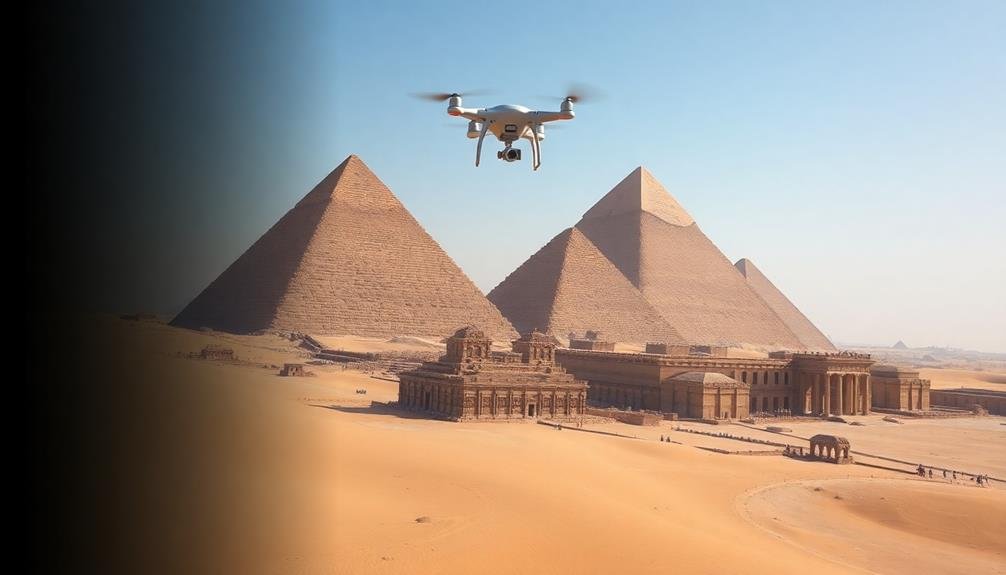
Before you take off, carefully plan your flight path to capture the best angles of the ancient landmark. Study maps and satellite imagery to identify key features and potential obstacles. Consider the sun's position throughout the day to determine ideal lighting conditions for your shots.
Scout the area on foot first, noting any restricted zones or sensitive areas you'll need to avoid. Identify safe takeoff and landing spots, as well as alternate locations in case of unexpected issues. Plan your flight altitude changes to capture both sweeping vistas and detailed close-ups of the landmark's architecture.
Factor in battery life and flight time limitations when plotting your route. It's wise to break your shoot into multiple shorter flights rather than attempting one long session. This approach allows you to review footage and adjust your plan as needed.
Don't forget to account for wind conditions and potential interference from other drones or aircraft. Have a contingency plan ready in case you need to abort your flight quickly.
Focus on Unique Perspectives
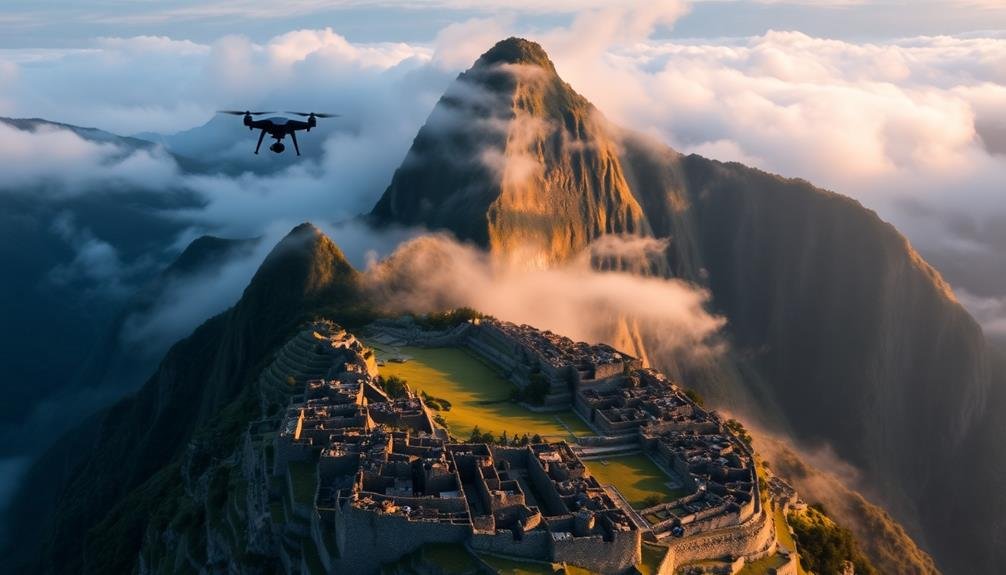
You'll discover hidden aspects of ancient landmarks when you capture them from above.
Aerial angles can reveal architectural details and spatial relationships that aren't visible from the ground.
Aerial Angles Reveal Secrets
Soaring high above ancient landmarks, drones have revolutionized how we view and understand these timeless structures. From this lofty vantage point, you'll uncover secrets that have eluded ground-based observers for centuries. Aerial angles provide a fresh perspective on the scale, layout, and intricate details of these architectural marvels.
You'll be amazed at how drone footage reveals hidden patterns and designs that aren't visible from the ground. These bird's-eye views can expose ancient city layouts, intricate crop circles, and even undiscovered structures buried beneath the earth. By capturing images from various altitudes and angles, you'll gain a thorough understanding of how these landmarks fit into their surrounding landscape.
Here are some ways aerial angles can reveal secrets:
- Expose hidden geometric patterns and alignments
- Highlight erosion and structural damage not visible from ground level
- Identify potential archaeological sites for further exploration
- Reveal the true scale and complexity of ancient complexes
With drone technology, you're not just observing these wonders; you're uncovering their hidden stories. By carefully analyzing aerial footage, you'll contribute to our collective understanding of ancient civilizations and their remarkable achievements.
Bird's-Eye View Reimagined
Drone technology has revolutionized our perception of ancient landmarks, offering a bird's-eye view that's truly reimagined. You'll discover unique perspectives that were once impossible to capture, transforming familiar sites into breathtaking new visions.
When flying your drone, experiment with different altitudes to reveal hidden patterns and layouts. Capture the Nazca Lines in Peru from various heights to showcase their intricate designs. At Stonehenge, hover your drone to highlight the circular arrangement and surrounding landscape.
For Egypt's pyramids, ascend gradually to demonstrate their massive scale against the desert backdrop. Try unconventional angles to create striking compositions. Fly diagonally across Machu Picchu to emphasize its terraced architecture.
At Angkor Wat, position your drone to capture the symmetry of its towers reflected in the surrounding water. For the Great Wall of China, follow its winding path to illustrate its vast expanse.
Use lighting to your advantage. Shoot during golden hour to cast long shadows across the Acropolis, emphasizing its architectural details. Capture Petra at sunrise to showcase the rosy hues of its carved facades.
Utilize Panoramic Shots
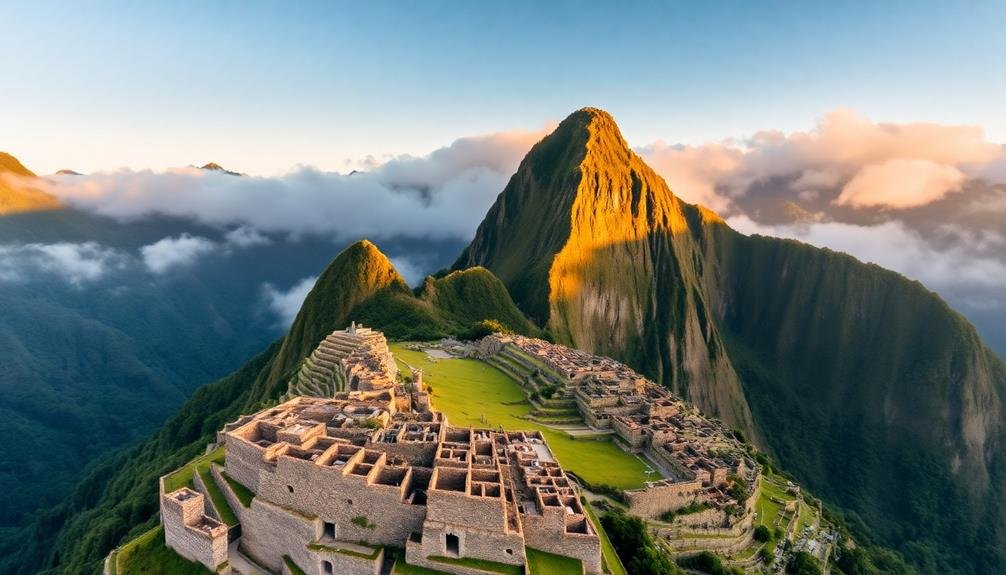
Panoramic shots offer a breathtaking perspective of ancient landmarks that's hard to achieve from ground level. With your drone, you'll capture the full scale and grandeur of these historical sites.
Start by selecting a vantage point that showcases the entire structure and its surroundings. Fly your drone in a circular pattern, maintaining a consistent altitude and distance from the landmark.
To create stunning panoramas, follow these tips:
- Use your drone's built-in panorama mode if available
- Manually capture a series of overlapping images for stitching later
- Maintain a steady flight path to guarantee smooth shifts between shots
- Adjust your camera settings for consistent exposure across all images
When editing, stitch your images together using specialized software. Pay attention to alignment and blending to create a seamless final product.
Experiment with different aspect ratios to find the most impactful composition. Consider including foreground elements to add depth and context to your panorama.
Highlight Scale and Surroundings
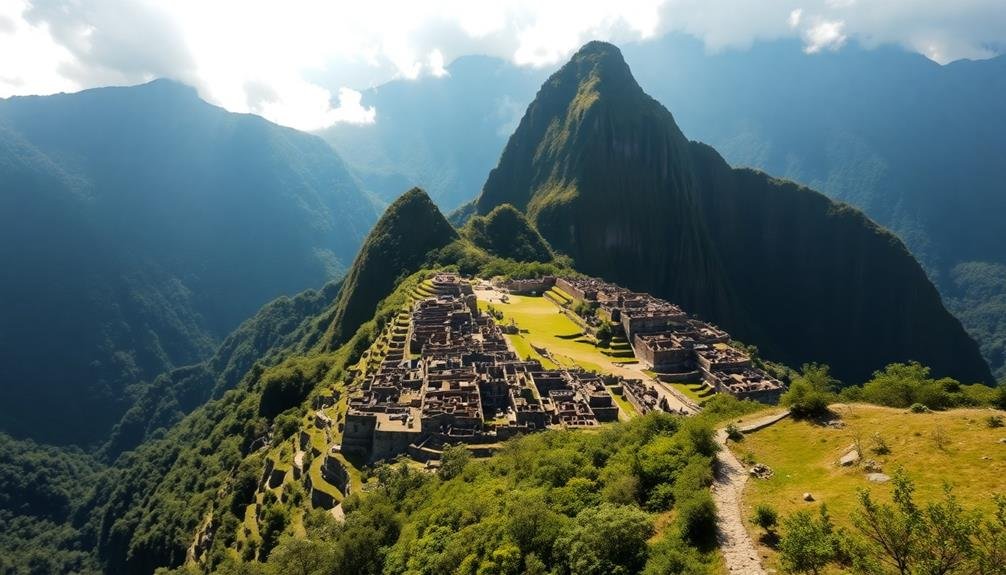
You'll gain a new appreciation for ancient landmarks through aerial context shots that showcase their massive scale within the surrounding landscape.
By juxtaposing ancient structures with modern developments, you can instantly grasp the passage of time and the enduring nature of these monuments.
From above, you'll also uncover hidden patterns and layouts that aren't visible from ground level, offering fresh insights into the design and purpose of these historical sites.
Aerial Context Shots
From high above, aerial context shots reveal the true grandeur of ancient landmarks. These enchanting images showcase the site's relationship with its surroundings, offering a unique perspective that ground-level photography can't match.
You'll capture the vastness of the landscape, highlighting how ancient civilizations chose specific locations for their monumental structures.
When taking aerial context shots, consider the following:
- Fly at different altitudes to show various levels of detail
- Capture the landmark from multiple angles to highlight its orientation
- Include natural features like rivers, mountains, or coastlines
- Showcase modern development surrounding the ancient site
As you frame your shots, pay attention to the interplay between light and shadow. Early morning or late afternoon sun can create dramatic contrasts, emphasizing the contours of the landscape.
Don't forget to adjust your camera settings for the increased distance and potential atmospheric haze.
Juxtapose Ancient and Modern
Drones allow for striking comparisons between ancient landmarks and their modern surroundings. You'll want to capture shots that highlight the contrast between old and new, emphasizing the scale and context of these historic sites in today's world.
Position your drone to frame the ancient structure alongside modern buildings or infrastructure. Seek out angles that showcase the size difference between the landmark and contemporary structures. For example, capture the Pyramids of Giza with Cairo's skyline in the background, or Machu Picchu nestled among the Andes Mountains with nearby tourist facilities visible.
Use your drone's height to your advantage. Ascending higher can reveal how an ancient site fits into the broader landscape, including modern roads, power lines, or urban sprawl. Look for opportunities to juxtapose traditional architecture with modern materials and designs.
Consider time-lapse shots that show the ebb and flow of modern life around a timeless monument. Capture the interplay of light and shadow as the day progresses, revealing how the ancient structure's appearance changes while modern elements remain constant.
These contrasts will help viewers appreciate the enduring nature of these landmarks amid evolving cityscapes and landscapes.
Reveal Hidden Patterns
Aerial perspectives offer unique insights into the hidden patterns and layouts of ancient landmarks. With drone photography, you'll uncover geometric designs, architectural symmetry, and land-use patterns that aren't visible from ground level. These birds-eye views reveal the true scale and intricate planning behind these monumental structures.
When capturing hidden patterns, focus on:
- Geometric shapes and alignments
- Repetitive elements and symmetry
- Landscape integration and topographical features
- Subtle color variations and shadows
You'll want to fly your drone at various altitudes to capture different scales of patterns. Lower flights can highlight intricate details, while higher altitudes showcase broader layouts and surrounding landscapes.
Pay attention to the interplay between natural and man-made elements, as ancient builders often incorporated celestial alignments or natural features into their designs.
Experiment with different times of day to capture changing shadows, which can accentuate hidden patterns. Early morning or late afternoon light often provides the best contrast.
Don't forget to take into account seasonal changes, as some patterns may only become visible during specific times of the year due to vegetation changes or solar alignments.
Enhance Post-Processing Techniques
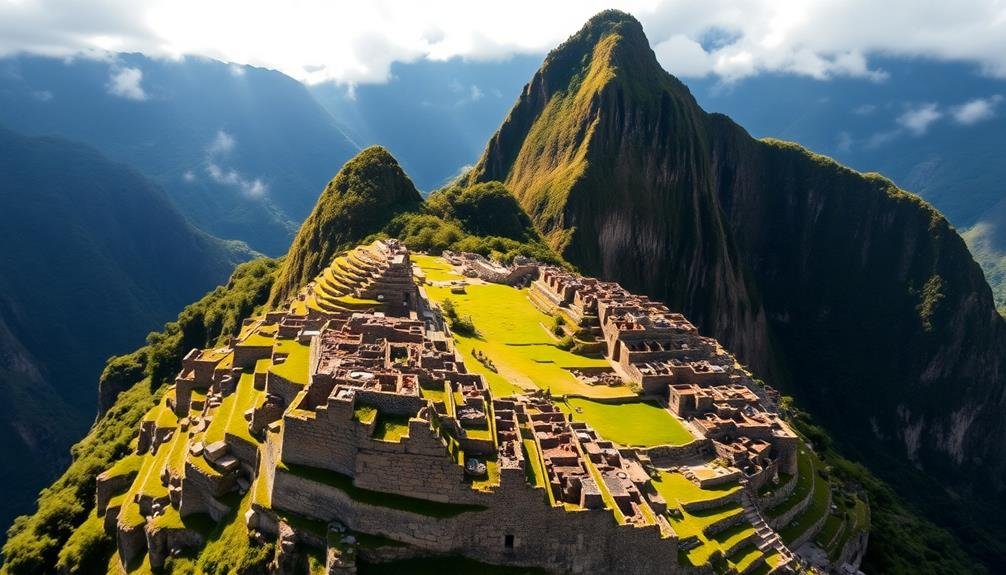
Post-processing wizardry breathes new life into drone-captured images of ancient landmarks.
You'll want to leverage advanced editing techniques to enhance your aerial shots and bring out the best in these historical wonders.
Start by adjusting the exposure and contrast to balance the light and shadows, revealing intricate details often lost in raw footage.
Use selective color adjustments to emphasize the unique hues of weathered stones or surrounding landscapes.
Apply sharpening tools judiciously to accentuate architectural features without introducing noise.
For a dramatic effect, experiment with HDR merging to capture the full dynamic range of your scene.
This technique is particularly useful for shots with challenging lighting conditions.
Don't shy away from perspective correction tools to straighten lines and eliminate distortion caused by wide-angle lenses.
Consider using subtle vignetting to draw the viewer's eye to the landmark's focal point.
For a polished look, remove distracting elements like modern structures or vehicles using content-aware fill tools.
Tell a Story Through Footage
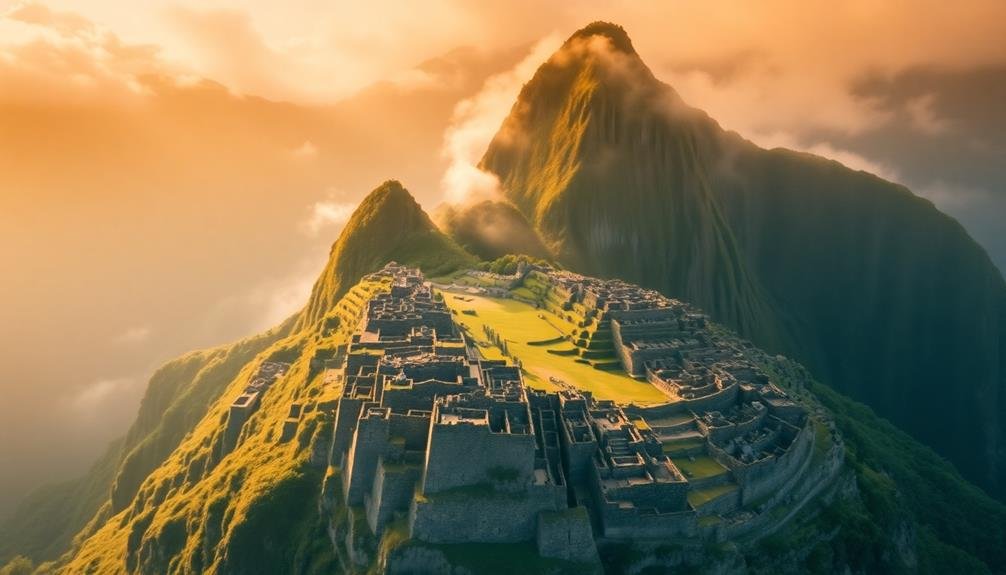
Often, the most enchanting drone footage of ancient landmarks goes beyond mere visual spectacle to weave a compelling narrative. To tell a story through your footage, you'll need to plan your shots carefully and consider the sequence in which you'll present them.
Start by establishing the location with a wide, sweeping shot that captures the landmark in its entirety. Then, gradually move closer, revealing intricate details and unique perspectives that ground-based cameras can't capture.
As you edit your footage, think about the emotions and atmosphere you want to convey. Use transitions and pacing to create a sense of journey or discovery. Consider incorporating elements that show the passage of time, such as shadows moving across ancient stones or the changing colors of the sky at different times of day.
To engage your audience and tell a compelling story:
- Use a mix of wide, medium, and close-up shots
- Capture human elements to provide scale and context
- Highlight lesser-known features or hidden details
- Show the landmark's relationship to its surroundings
Frequently Asked Questions
How Do You Protect Drones From Extreme Weather at Ancient Sites?
You'll want to protect your drone from extreme weather at ancient sites by using a waterproof case, checking forecasts, avoiding strong winds, and flying in temperate conditions. Don't forget to install protective propeller guards for added safety.
What Insurance Options Are Available for Drone Photography of Landmarks?
You'll want to contemplate specialized drone insurance for your landmark photography. It can cover liability, equipment damage, and property damage. Check with providers like DJI or Verifly for options tailored to commercial drone use at historical sites.
How Can You Minimize Disturbing Wildlife When Filming Ancient Sites?
You'll want to keep your distance, fly during less active hours, and avoid nesting areas. Use quieter drones, plan your flight path carefully, and follow local wildlife guidelines. Don't chase or harass animals with your drone.
Are There Special Permits Required for Commercial Drone Use at Landmarks?
You'll often need special permits for commercial drone use at landmarks. Check local regulations, as they vary by location. Contact the site's management or local authorities to obtain necessary permissions before flying your drone commercially.
What Are the Best Practices for Drone Battery Management in Remote Locations?
You'll want to pack extra batteries and a portable charger. Keep batteries warm in cold weather, and cool in hot conditions. Don't overcharge them, and always monitor battery levels. Plan your flights carefully to maximize battery life.
In Summary
You've now got the tools to capture breathtaking aerial footage of ancient landmarks. Remember, it's not just about the technology; it's about your vision and respect for these historic sites. As you soar above these wonders, you're creating a unique perspective that bridges past and present. Keep practicing, stay safe, and don't forget to share your stunning shots. You're not just taking photos; you're preserving history from a whole new angle.

As educators and advocates for responsible drone use, we’re committed to sharing our knowledge and expertise with aspiring aerial photographers.
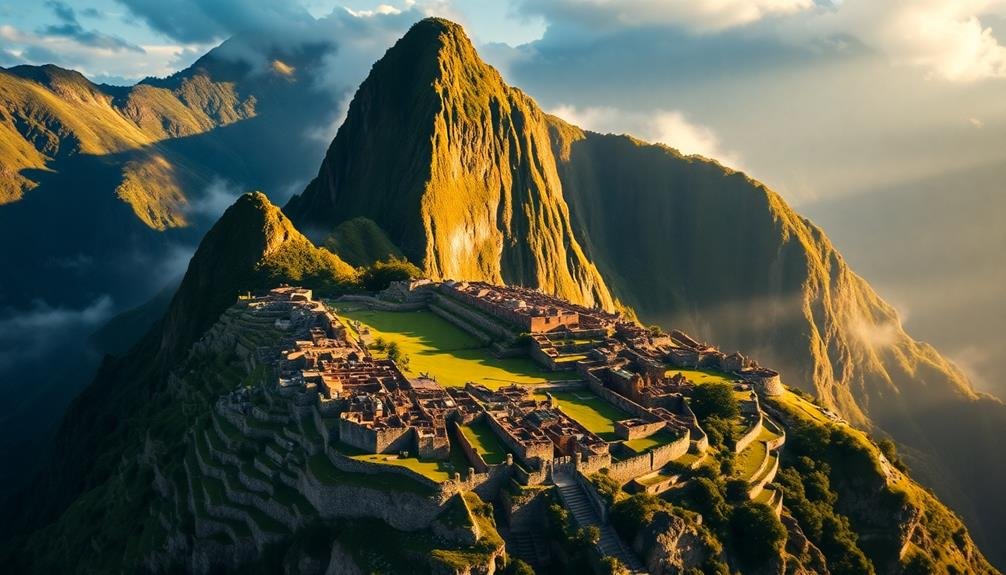



Leave a Reply